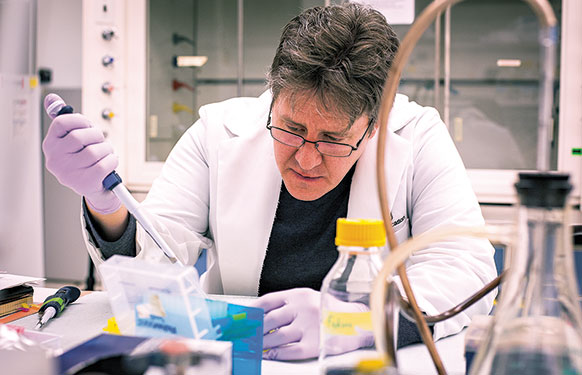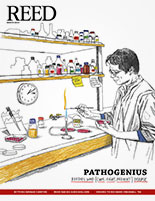
IRIS login | Reed College home Volume 92, No. 1: March 2013
Signal Master

The conundrum of multiple sclerosis is that the brain can—at least in theory—repair itself. Larry Sherman is trying to figure out why the healing process gets derailed. Photo by Ronit Fahl
Neuroscientist Larry Sherman ’86 wants to regenerate your brain.
by Geoff Koch
Irreversible. Incurable. Fatal.
Those three facts about multiple sclerosis were drilled into every doctor’s head, starting with the great French neurologist Jean-Martin Charcot, who in 1868 first described the sinister autoimmune disorder that targets the brain and spinal cord.
In the last 30 years, each of these certainties has begun to wobble. Patients live longer. The attacks, which result in symptoms from fatigue to blindness, can now be treated. And it is no longer preposterous to contemplate reversing the brain lesions that are the hallmark of the disease—thanks to the work of Oregon Health and Science University neuroscientist Larry Sherman ’86, who in October published his most significant scientific result yet.
The study, in the Annals of Neurology, hints at an answer to one of the central mysteries of MS and points the way—potentially—to a mechanism for doing what doctors have tried to do for centuries: help the brain to heal itself.
![]()
Roughly 400,000 Americans and 2.5 million people worldwide suffer from MS. Although there are some nuances in its population distribution—it strikes more women than men and is more common in Caucasians of northern European origin—it doesn’t discriminate based on age, race, or class. Last fall, Ann Romney, wife of former presidential hopeful Mitt Romney, spoke openly of her struggles with the disease. Michelle Obama often speaks about the travails and courage of her father, who died in 1991 after a long and painful battle with MS. In an interview that aired in September on The Dr. Oz Show, the famously health-conscious First Lady said that thinking about her father’s condition triggers her biggest health fear—“sudden illnesses that may be genetically linked that you don’t have any control over.”
MS treatment has come a long way since Larry was a biology major at Reed. Back then, conventional wisdom held that the brain was incapable of repairing itself. Since then, a slew of drugs and other interventions have been developed that can control the disease, at least partially, by preventing the immune system from launching attacks in the first place. Unfortunately, the drugs often have fleeting impact and horrendous side effects.
In his 2004 book Blindsided: Lifting a Life Above Illness, Richard M. Cohen, a former senior producer for CBS News and CNN, wrote about living with MS. “Dr. Frankenstein dreamed up this therapy,” Cohen says about receiving steroid injections for his condition. “Anyone who is not a mess going into the hospital for intensive steroid treatment is a maniac on departure. . . . Steroids made me fat and crazy. My mood swings were wild.”
MS is fundamentally a disease of myelin, a tough sheath which insulates nerve cells in the brain and throughout the body. Thanks to myelin, this cell network normally hums with electrical and chemical signals that in sum comprise the experience of a healthy human being moving through the world. In MS, the cause of which is still a mystery, the body’s own immune system attacks myelin. Stripped of their insulation, the nerve cells slow down or stop firing altogether. Think sugar in the gas tank and sand in the gears. The resulting symptoms can be devastating: blindness, hearing loss, loss of balance, weakness, memory loss, and cognitive impairment. On an MRI scan, demyelination shows up as malevolent lesions on the brain, not unlike dead patches of coral on a reef that should be teeming with life.
The conundrum of MS is that—at least in theory—the brain can deploy a counterweapon. In recent years, scientists have learned that when lesions start occurring, the brain cranks up production of oligodendrocytes, cells that build new myelin. Eventually, however, something shuts down this production line, which, if left to run at full steam, might reverse the course of the disease.
Larry’s research suggests the culprit flipping the stop switch is an enzyme known as PH20, which happens to be produced by the same cells that trigger creation of new oligodendrocytes. In other words, when it comes to MS, the seeds of salvation and suffering are bound up together. It turns out that PH20 breaks apart a certain largish sugar molecule, hyaluronic acid, that builds up at the lesions and is thought to be part of the body’s anti-inflammatory response. The smaller, broken-up remnants of what used to be hyaluronic acid are what seem to gum up the works.
The situation is sort of like a fire department sending trucks to fight a fire in a skyscraper (an MS attack causes demyelination). Trucks show up and douse the flames for a while (oligodendrocytes build new myelin). But the trucks’ noisy sirens and flashing lights cause such panic that people flee haphazardly into the streets around the building, preventing new trucks from arriving (the PH20 enzyme breaks up hyaluronic acid, and the resulting bits of brain chemistry prevent new oligodendrocytes from forming).
This research suggests that if a drug could be developed to target PH20—to shut off the siren and lights, as it were—then the restorative process of resheathing nerve cells in protective myelin might proceed unabated.
Based on earlier studies, some MS researchers had concluded the most promising approach might be a drug that silences PH20 and a whole family of related enzymes. But this broad-brush approach was problematic since these other enzymes are key to healthy joints and even to proper functioning of the heart.
“The side effects would probably be much worse than MS,” Larry says.
By contrast, PH20 plays a significant role in only one other area of the body, one that’s only important in certain contexts—sperm cells. This means one side effect of a drug aimed solely at PH20 might be what Sherman calls transient male infertility.
“I think most people would be okay with that; women certainly will be,” he says wryly. “And men probably will be, too. They’d rather have their myelin back than worry about reproducing.”
“We’re very early on and any treatment realistically is many years away,” says Bruce Bebo, associate vice president of discovery research for the National Multiple Sclerosis Society. “But Dr. Sherman’s recent finding is a milestone. He and his colleagues have identified a specific target for drug treatment that might eventually lead to an ability to repair damage to myelin. There’s hope.”


LATEST COMMENTS
steve-jobs-1976 I knew Steve Jobs when he was on the second floor of Quincy. (Fall...
Utnapishtim - 2 weeks ago
Prof. Mason Drukman [political science 1964–70] This is gold, pure gold. God bless, Prof. Drukman.
puredog - 1 month ago
virginia-davis-1965 Such a good friend & compatriot in the day of Satyricon...
czarchasm - 4 months ago
John Peara Baba 1990 John died of a broken heart from losing his mom and then his...
kodachrome - 7 months ago
Carol Sawyer 1962 Who wrote this obit? I'm writing something about Carol Sawyer...
MsLaurie Pepper - 8 months ago
William W. Wissman MAT 1969 ...and THREE sisters. Sabra, the oldest, Mary, the middle, and...
riclf - 10 months ago